 Technology peripherals
Technology peripherals
 AI
AI
 AI imitates the memory model of the human brain, and game scores soared by 29.9%
AI imitates the memory model of the human brain, and game scores soared by 29.9%
AI imitates the memory model of the human brain, and game scores soared by 29.9%
We are often taught to "think twice before acting" and make full use of accumulated experience. Now this sentence has also inspired AI.
Traditional decision-making AI models cannot effectively accumulate experience due to the existence of the forgetting effect, but a Chinese-led research has changed the memory method of AI.
The new memory method imitates the human brain, effectively improving the efficiency of AI in accumulating experience, thereby increasing AI's game performance by 29.9%.
The research team consists of six people, respectively from Mira-Québec AI Research Institute and Microsoft Montreal Research Institute, four of whom are Chinese.
They named the result Decision Transformer with Memory (DT-Mem).
Compared with traditional decision-making models, DT-Mem is more widely applicable and the efficiency of model operation is also higher.
In addition to the application effect, the training time of DT-Mem has also been shortened from a minimum of 200 hours to 50 hours.
At the same time, the team also proposed a fine-tuning method to allow DT-Mem to adapt to new scenarios that have not been trained.
The fine-tuned model can also perform well in games that it has not learned before.
The working mechanism is inspired by humans
The traditional decision-making model is designed based on LLM and uses implicit memory, and its performance depends on data and calculation.
Implicit memories are generated unconsciously rather than deliberately remembered, and therefore cannot be recalled consciously.
To put it more simply, the relevant content is obviously stored there, but the model does not know its existence.
This characteristic of implicit memory determines the forgetting phenomenon in traditional models, resulting in low work efficiency.
The forgetting phenomenon is manifested in that after learning a new way to solve a problem, the model may forget the old content, even if the old and new problems are of the same type.
The human brain adopts a distributed memory storage method, and the memory content is dispersedly stored in multiple different areas of the brain.
This approach helps to effectively manage and organize multiple skills, thereby mitigating the phenomenon of forgetting.
Inspired by this, the research team proposed an internal working memory module to store, mix and retrieve information for different downstream tasks.
Specifically, DT-Mem consists of three parts: Transformer, memory module and multi-layer perception (MLP) module.
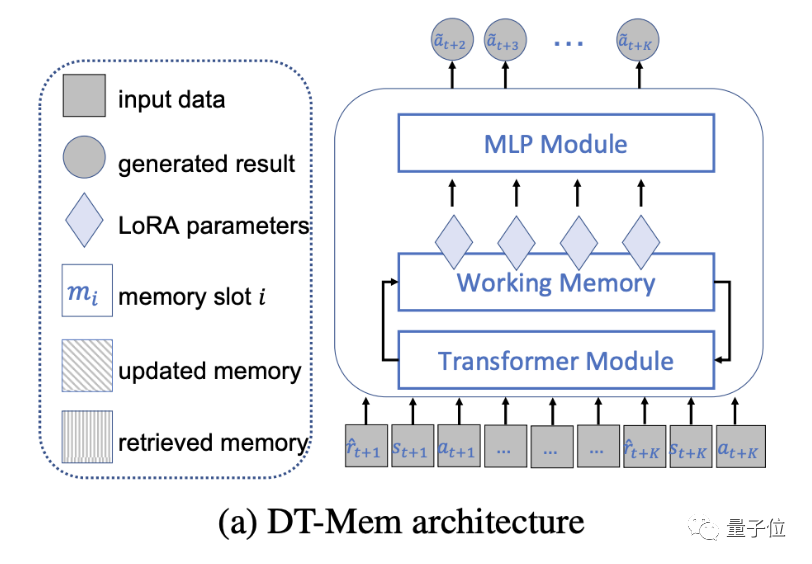
DT-Mem’s Transformer imitates the architecture of GPT-2, but deletes the feed-forward layer after the attention mechanism.
At the same time, the MLP module in GPT-2 is split into independent components as part of DT-Mem.
Between the two, the research team introduced a working memory module to store and process intermediate information.
This structure is inspired by neural Turing machines, in which the memory is used to infer various algorithms.
The memory module analyzes the information output by the Transformer and determines its storage location and how to integrate it with existing information.
In addition, this module also considers how this information will be used in future decision-making processes.
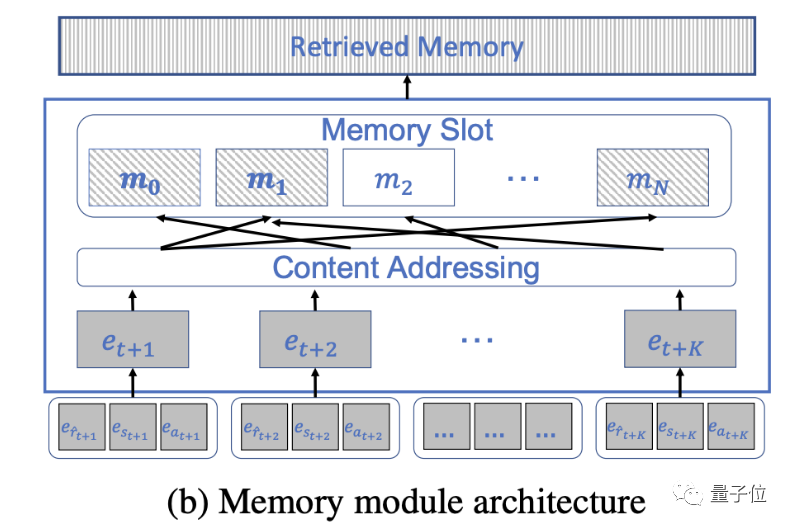
These tasks are roughly completed in five steps. The memory module is first initialized as a random matrix.
Then comes the sorting of the input information. This step is not to pass the information to the Transformer, but to store it in the same space in the form of tuples.
After that, you need to determine the storage location. Humans usually store related information in the same location, and DT-Mem is also based on this principle.
The last two steps - memory update and retrieval are the core of the memory module and the most important link in the entire DT-Mem.
Memory update means editing and replacing existing information to ensure that the information can be updated in time according to the needs of the task.
In this step, DT-Mem will calculate the erase and write vectors to determine how to mix them with existing data.
Memory retrieval is the access and recovery of existing information, and timely retrieval of relevant and useful information when decisions need to be made.
Before being put into actual use, DT-Mem still needs to go through a pre-training process.
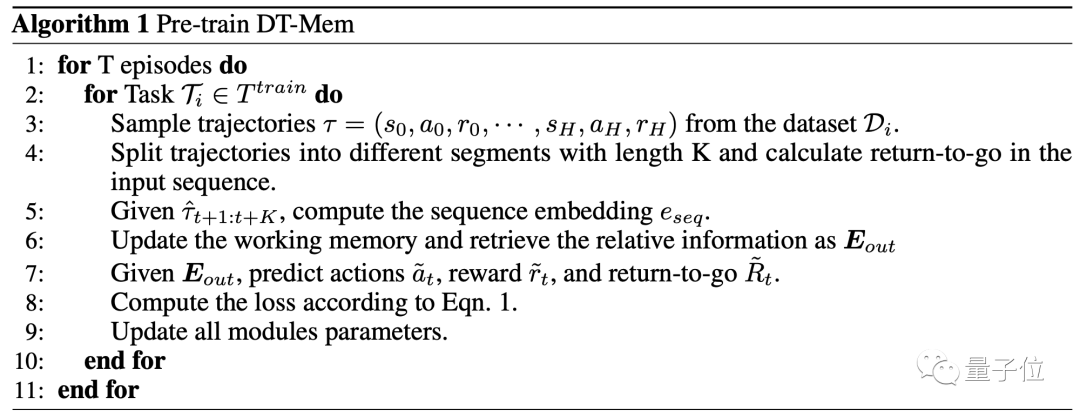
As for the fine-tuning of DT-Mem, the team also proposed a new method.
Since it uses data labeled based on tasks, this kind of fine-tuning can help DT-Mem adapt to new tasks.
This process is based on low-rank adaptation (LoRA), adding low-rank elements to the existing matrix.
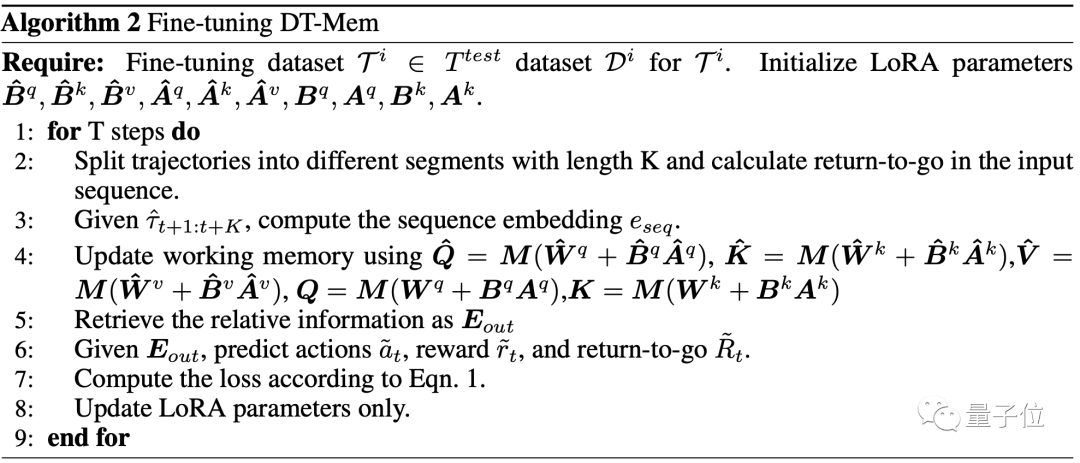
Training time is shortened by up to 32 times
To test DT-Mem’s decision-making ability, the research team let it play several games game.
There are 5 games in total, all from Atari.
At the same time, the team also tested the performance of the traditional model M[ulti-game]DT as a reference.
As a result, DT-Mem’s best results in 4 of the games were all better than MDT.
Specifically, DT-Mem improves the DQN normalized score by 29.9% compared to MDT.
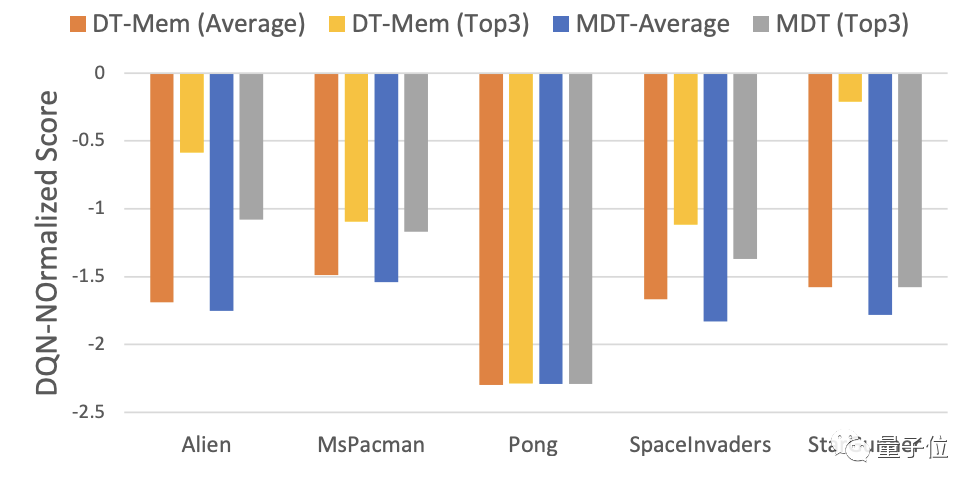
However, the parameter amount of DT-Mem is only 20M, which is only 10% of MDT (200M parameters).
Such a performance is not an exaggeration to say that it is a big deal.
In addition to its excellent performance, DT-Mem’s training efficiency also surpasses MDT.
The 13M parameter version of MDT takes 200 hours to train, while the 20M DT-Mem only takes 50 hours.
Compared with the 200M version, the training time is shortened by 32 times, but the performance is even better.

#The test results of the fine-tuning method proposed by the team also show that this fine-tuning enhances DT-Mem's ability to adapt to unknown scenarios.
It should be noted that the games used for testing in the table below are known to MDT, so MDT's performance is not used as a basis for measurement in this round.

In addition to playing games, the team also tested DT-Mem using the Meta-World ML45 benchmark.
The ones used as reference this time are H[yper]DT and P[romot]DT.
The results show that among the models without fine-tuning, DT-Mem scores are 8 percentage points higher than HDT.
It should be noted that although the HDT tested here has only 69K parameters, it relies on a pre-trained model with 2.3M parameters, so the actual parameter number is more than 10 times that of DT-Mem (147K). times.

Paper address: https://arxiv.org/ abs/2305.16338
The above is the detailed content of AI imitates the memory model of the human brain, and game scores soared by 29.9%. For more information, please follow other related articles on the PHP Chinese website!

Hot AI Tools

Undresser.AI Undress
AI-powered app for creating realistic nude photos

AI Clothes Remover
Online AI tool for removing clothes from photos.

Undress AI Tool
Undress images for free

Clothoff.io
AI clothes remover

Video Face Swap
Swap faces in any video effortlessly with our completely free AI face swap tool!

Hot Article

Hot Tools

Notepad++7.3.1
Easy-to-use and free code editor

SublimeText3 Chinese version
Chinese version, very easy to use

Zend Studio 13.0.1
Powerful PHP integrated development environment

Dreamweaver CS6
Visual web development tools

SublimeText3 Mac version
God-level code editing software (SublimeText3)

Hot Topics
 1386
1386
 52
52
 The world's most powerful open source MoE model is here, with Chinese capabilities comparable to GPT-4, and the price is only nearly one percent of GPT-4-Turbo
May 07, 2024 pm 04:13 PM
The world's most powerful open source MoE model is here, with Chinese capabilities comparable to GPT-4, and the price is only nearly one percent of GPT-4-Turbo
May 07, 2024 pm 04:13 PM
Imagine an artificial intelligence model that not only has the ability to surpass traditional computing, but also achieves more efficient performance at a lower cost. This is not science fiction, DeepSeek-V2[1], the world’s most powerful open source MoE model is here. DeepSeek-V2 is a powerful mixture of experts (MoE) language model with the characteristics of economical training and efficient inference. It consists of 236B parameters, 21B of which are used to activate each marker. Compared with DeepSeek67B, DeepSeek-V2 has stronger performance, while saving 42.5% of training costs, reducing KV cache by 93.3%, and increasing the maximum generation throughput to 5.76 times. DeepSeek is a company exploring general artificial intelligence
 AI subverts mathematical research! Fields Medal winner and Chinese-American mathematician led 11 top-ranked papers | Liked by Terence Tao
Apr 09, 2024 am 11:52 AM
AI subverts mathematical research! Fields Medal winner and Chinese-American mathematician led 11 top-ranked papers | Liked by Terence Tao
Apr 09, 2024 am 11:52 AM
AI is indeed changing mathematics. Recently, Tao Zhexuan, who has been paying close attention to this issue, forwarded the latest issue of "Bulletin of the American Mathematical Society" (Bulletin of the American Mathematical Society). Focusing on the topic "Will machines change mathematics?", many mathematicians expressed their opinions. The whole process was full of sparks, hardcore and exciting. The author has a strong lineup, including Fields Medal winner Akshay Venkatesh, Chinese mathematician Zheng Lejun, NYU computer scientist Ernest Davis and many other well-known scholars in the industry. The world of AI has changed dramatically. You know, many of these articles were submitted a year ago.
 Google is ecstatic: JAX performance surpasses Pytorch and TensorFlow! It may become the fastest choice for GPU inference training
Apr 01, 2024 pm 07:46 PM
Google is ecstatic: JAX performance surpasses Pytorch and TensorFlow! It may become the fastest choice for GPU inference training
Apr 01, 2024 pm 07:46 PM
The performance of JAX, promoted by Google, has surpassed that of Pytorch and TensorFlow in recent benchmark tests, ranking first in 7 indicators. And the test was not done on the TPU with the best JAX performance. Although among developers, Pytorch is still more popular than Tensorflow. But in the future, perhaps more large models will be trained and run based on the JAX platform. Models Recently, the Keras team benchmarked three backends (TensorFlow, JAX, PyTorch) with the native PyTorch implementation and Keras2 with TensorFlow. First, they select a set of mainstream
 Hello, electric Atlas! Boston Dynamics robot comes back to life, 180-degree weird moves scare Musk
Apr 18, 2024 pm 07:58 PM
Hello, electric Atlas! Boston Dynamics robot comes back to life, 180-degree weird moves scare Musk
Apr 18, 2024 pm 07:58 PM
Boston Dynamics Atlas officially enters the era of electric robots! Yesterday, the hydraulic Atlas just "tearfully" withdrew from the stage of history. Today, Boston Dynamics announced that the electric Atlas is on the job. It seems that in the field of commercial humanoid robots, Boston Dynamics is determined to compete with Tesla. After the new video was released, it had already been viewed by more than one million people in just ten hours. The old people leave and new roles appear. This is a historical necessity. There is no doubt that this year is the explosive year of humanoid robots. Netizens commented: The advancement of robots has made this year's opening ceremony look like a human, and the degree of freedom is far greater than that of humans. But is this really not a horror movie? At the beginning of the video, Atlas is lying calmly on the ground, seemingly on his back. What follows is jaw-dropping
 KAN, which replaces MLP, has been extended to convolution by open source projects
Jun 01, 2024 pm 10:03 PM
KAN, which replaces MLP, has been extended to convolution by open source projects
Jun 01, 2024 pm 10:03 PM
Earlier this month, researchers from MIT and other institutions proposed a very promising alternative to MLP - KAN. KAN outperforms MLP in terms of accuracy and interpretability. And it can outperform MLP running with a larger number of parameters with a very small number of parameters. For example, the authors stated that they used KAN to reproduce DeepMind's results with a smaller network and a higher degree of automation. Specifically, DeepMind's MLP has about 300,000 parameters, while KAN only has about 200 parameters. KAN has a strong mathematical foundation like MLP. MLP is based on the universal approximation theorem, while KAN is based on the Kolmogorov-Arnold representation theorem. As shown in the figure below, KAN has
 FisheyeDetNet: the first target detection algorithm based on fisheye camera
Apr 26, 2024 am 11:37 AM
FisheyeDetNet: the first target detection algorithm based on fisheye camera
Apr 26, 2024 am 11:37 AM
Target detection is a relatively mature problem in autonomous driving systems, among which pedestrian detection is one of the earliest algorithms to be deployed. Very comprehensive research has been carried out in most papers. However, distance perception using fisheye cameras for surround view is relatively less studied. Due to large radial distortion, standard bounding box representation is difficult to implement in fisheye cameras. To alleviate the above description, we explore extended bounding box, ellipse, and general polygon designs into polar/angular representations and define an instance segmentation mIOU metric to analyze these representations. The proposed model fisheyeDetNet with polygonal shape outperforms other models and simultaneously achieves 49.5% mAP on the Valeo fisheye camera dataset for autonomous driving
 Tesla robots work in factories, Musk: The degree of freedom of hands will reach 22 this year!
May 06, 2024 pm 04:13 PM
Tesla robots work in factories, Musk: The degree of freedom of hands will reach 22 this year!
May 06, 2024 pm 04:13 PM
The latest video of Tesla's robot Optimus is released, and it can already work in the factory. At normal speed, it sorts batteries (Tesla's 4680 batteries) like this: The official also released what it looks like at 20x speed - on a small "workstation", picking and picking and picking: This time it is released One of the highlights of the video is that Optimus completes this work in the factory, completely autonomously, without human intervention throughout the process. And from the perspective of Optimus, it can also pick up and place the crooked battery, focusing on automatic error correction: Regarding Optimus's hand, NVIDIA scientist Jim Fan gave a high evaluation: Optimus's hand is the world's five-fingered robot. One of the most dexterous. Its hands are not only tactile
 The latest from Oxford University! Mickey: 2D image matching in 3D SOTA! (CVPR\'24)
Apr 23, 2024 pm 01:20 PM
The latest from Oxford University! Mickey: 2D image matching in 3D SOTA! (CVPR\'24)
Apr 23, 2024 pm 01:20 PM
Project link written in front: https://nianticlabs.github.io/mickey/ Given two pictures, the camera pose between them can be estimated by establishing the correspondence between the pictures. Typically, these correspondences are 2D to 2D, and our estimated poses are scale-indeterminate. Some applications, such as instant augmented reality anytime, anywhere, require pose estimation of scale metrics, so they rely on external depth estimators to recover scale. This paper proposes MicKey, a keypoint matching process capable of predicting metric correspondences in 3D camera space. By learning 3D coordinate matching across images, we are able to infer metric relative



